-853X543.jpg)
ILA ARUN: GIVING VOICE TO LIFE
by Aparajita Krishna July 12 2022, 12:00 am Estimated Reading Time: 29 mins, 1 secIla Arun is a woman of many parts and one who is in command of all of them. She has a contagious zest for life, writes Aparajita Krishna
Over the decades she steadfastly built her repertoire in radio, theatre, television, films and music as broadcaster-actor-playwright-writer-singer-composer. A very concise resume would highlight her work with Jaipur Akashwani as a child-artist, casual announcer with Vividh Bharati, Doordarshan, contributor to BBC Radio (Hindi) London in 1975, stage actor through the years, television and film actor notably in Shyam Benegal’s works since 1982, acts in films like Thugs Of Hindustan, Manto, Begum Jaan, Jodhaa Akbar, West is West (British Film), Ghoomketu, as well as judge and mentor on music programmes and award shows.
Her international beat boasts of having sung Ringa Ringa with Alka Yagnik for the Oscar winning film Slumdog Millionaire. She was also the voice of Rajasthan Royals anthem song ‘Halla Bol’ for inaugural IPL T20 Cricket League. She has performed in hundreds of Live ‘ILA ARUN Musical Shows’ in India and around the world. She has written lyrics, composed music and sung for over a dozen of her own Folk and Pop audio albums. She has done playback singing for over fifty Hindi and regional feature films. All this has earned Ila her a unique stamp, awards and recognition both in India and abroad.
Her note of gratitude says, “I had a fantastic, satisfying life. I am enriched. God has been kind to me. I got more than I deserved also. Whenever the opportunity came my way, I have through my plays and music celebrated women. Also commented on certain hidden aspects of our life.” She also informs us, “I am already writing a book, my memoir. I want to publish it in English and Hindi.”
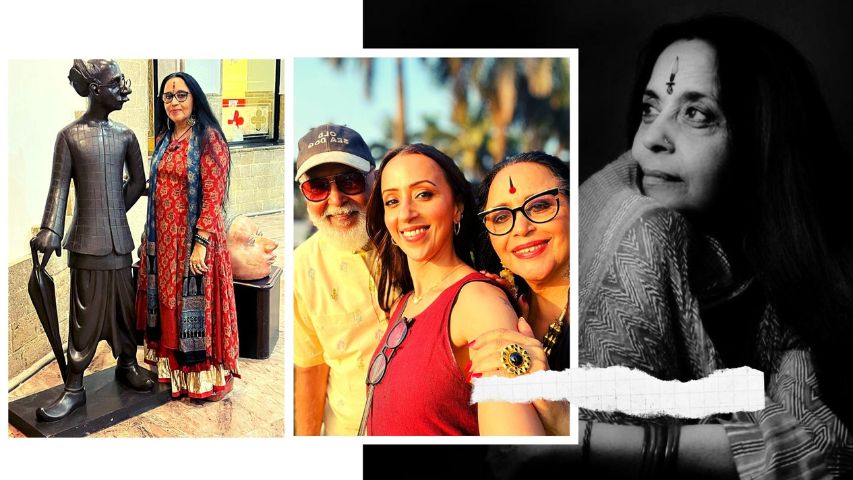
Ila is her own person and also a wife, mother, family member and friend. On the 23rd of May this year, we reconnected on the occasion of the book release of Pandeymonium, authored by her brother Piyush Pandey, who is the executive chairman and creative director for Ogilvy & Mather India and South Asia. This year also happens to be her theatre group, Surnai Theatre And Folk-Arts Foundation’s 40th Anniversary. She says, “11th June 1982, by the inspiration of Mrs Jennifer Kapoor we started the group. This 11th June 2022 is its 40th anniversary. I want to have a yearlong celebration. I will do plays and other activities. There will also be a folk-theatre-festival and a folk evening to culminate it. If possible, we plan to revive our top plays and add a new Ibsen play, Ajatshatru - An Enemy of the People.”
Surnai has over the years staged many original and adapted plays with more than 350 shows of Hindi plays. Ila and KK Raina have helmed the group with steadfastness. They have been holding the Ibsen Festival for the last seven years, leveraging the adapted plays to be performed also by other Indian groups and theater practitioners in Hindi, English and other regional languages. Ila has also written original Hindi plays besides having acted in the title role of Bilquis Bibi in the English play ‘The House of Bilquis Bibi’ when staged in London.
Over voicemails, amidst theatre engagements, she voiced a summary of her life and works. In between she would also inform me, ‘Sorry my helper is standing in front. I think she needs some money for groceries. Can you believe my girl has gone and returned after buying paneer from Khar (a good distance away from her house) and here I am still talking to you!’
Her prologue says, “What to keep, what to eliminate? What moments to choose, digest, chew over? So much of work got done? And here I am still feeling that I did not get the deserved break. In your questions lie those moments of my life that developed me into a personality. Be they good or bad, but they were precious to me. Answering this list of questions is akin to re-living my life.”
This girl-woman amongst seven sisters and two brothers has a fascinating and empowering familial backstory too. I have been fascinated by her apparently female-matriarchal power-genes even though her brothers Piyush Pandey and Prasoon Pandey are highly successful advertising and creative professionals. This article is a peek, a jhalki, into Ila’s life and work that befits a book for sure.
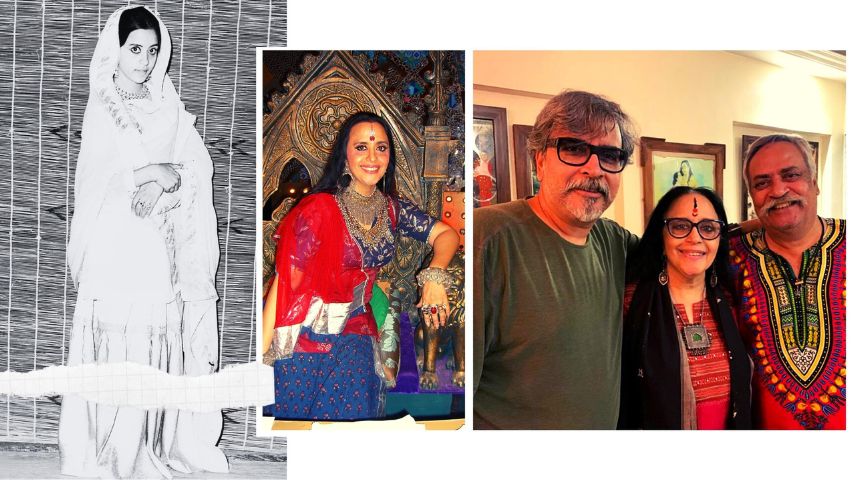
While I was compiling the questions, quite fortuitously on TV appeared the song ‘Meri Banno Hoshiyar’ from film Well Done Abba. It was sung and enacted by you as Salma Ali and was a very well rendered desi rap. I happened to change the channel and there appeared film Chhalanga (2020). You were very good as the principal. So, to begin in the present, how would you summarize your professional and personal journey so far?
In school I could never write a summary. Even when I adapt plays, they end up being very lengthy. A saransh of my long journey of life would be akin to turning life into a miniature painting. I have done so much of work with Shyam (Benegal) Babu. This above-mentioned song with Boman Irani, I enacted, sang and also worked on the tune. Shantanu Moitra put in his masterstroke and modernized it. Working with Shyam Benegal is not a chapter but a book. He introduced me in the film Mandi. When Jodha Akbar released then Amitji (Amitabh Bachchan) had also come for the screening. He asked me “Aap kya kya karti hain? Humein toh pata tha ki aap gaati hain!” So, to that I would say that whatever urge I had in me, I expressed that. There was some sur, some taal in me. There was some kind of a need to act. Then some desire to hold the pen. So, I kept working and recognition followed. It has been very, very satisfying.
I am a dreamer, but not too complexed. One has to balance, marry the personal and the professional life. We have to be real while acting but when we are dealing with real life one cannot act. Luckily Arun, my husband, and I have lived a well-led life. He was a sailor. The high and the low tides we have seen them all. He encouraged my art. He was always proud of my achievements and became a part of all that. He supervises my theatre management and looks after the publicity. Anjula Bedi, my friend and colleague, is my very big strength. She is not just Surnai’s prized actor, but the backbone and creative editor of Surnai. My daughter Ishita is god’s gift to me. I have always been a working mother. Ishita as a child accompanied me on shoots. She had such noted names as her baby-sitters: Soni Razdan, Anita Kanwar and Neena Gupta. With her father away to sea, she grew up in my work atmosphere; like children of theatre-parents do, growing up in the wings. Gaate-bajate zindagi achchi kat gayi, na natak choota na gaana. My godfather is Ebrahim Alkazi. My dream is that even if some day I stop doing theater, I should remain in costume to just sell tickets.
Once at the NSD I met Ritwik Ghatak. He turned to me and said in Bengali, ‘Ma, you will die on stage.’ I was young. Then I realized that what a blessing he was giving me! Every time I step onto Prithvi Theatre I tell God to make me die here only. Nothing to beat the stage.
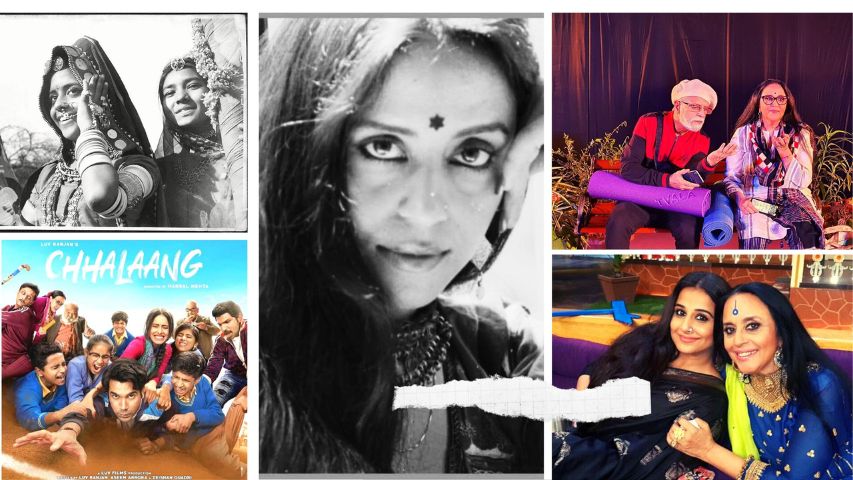
Theatre has admirably been a constant in your life?
On stage I have done many outstanding roles. For me stage was not a stepping stone to films. In my youth I did not get the film roles one deserved. KK Raina took Surnai as his own group. Surnai Theatre And Folk-Arts Foundation has only seven members and he is the whole and sole of that group now. Training, honesty, commitment, KK got from Alkazi Saheb. We are like daily-wage workers. We invest our money in the projects. My brothers Piyush Pandey and Prasoon Pandey have stood like rocks in support. Now my nephew Abhijit Avasthi tries arranging funds for us. Our credibility gets us the resources. It is built over forty years and over many works. People have done Andha Yug and Kanupriya, but not in the manner that we conceived and juxtaposed them in Shabd Leela. Pushpa Bharatiji also awarded us. I got so much to learn. Kya romance tha Krishna aur Radha ka! Aur kya romance tha Pushpaji aur Dharamveer Bharatiji ka! How nicely they have lived their creative works.
I adapted Lady from The Sea into Rajasthani (milieu) as Mareechika. Mareechika is that thirsty female-deer of Rajasthan that sees the illusion of water in the sandy deserts, but can never get to the water to quench her thirst. Her death is inevitable. What are the women-folk of Rajasthan like? They too are like that she-deer, hidden behind their veils of ghoonghat. They have no voice of their own. I turned it into a musical. Ibsen was so progressive even 150 years ago A Doll’s House. Back then a woman could dare not imagine shutting the domestic door on the husband or walking out on him. In our Rajasthan, women would become Sati, or commit Jauhar by jumping into the fire.
We adapted Ibsen’s classic Peer Gynt as Peer Ghani, a musical, set in Kashmir with terrorism at its peak. I named Hedda Gabler as Hardit Kaur Gill. Then did Ghost as Peecha Karti Parchhaiyan. Doing Ibsen matured me as a person and as a woman. If I can address even a single person of my society then my job is done. In today’s times there are many as self-obsessed as Hedda Gabbler who are not ready to see beyond themselves. They just keep talking to google and then commit suicide.
Surnai’s forty years is the highlight of my life. But theatre needs a lot of devotion. It cannot be business unless you have corporations with you. Hindi bolne wale Hindi plays dekhna nahi chahate. I have seen in Norway what kind of a crowd comes there to watch theater! That is special! It’s the same satisfaction I got now with our play Miracle On Matunga Street at NCPA experimental. So many senior citizens came to watch a live show.
Doing ten musical albums is also an achievement. To put them in Coke studio is noteworthy. Then in Norway to collaborate with composer Dhruv Ghanekar is also of note. I never thought I would be able to do so much. I will keep working till my age and breath allow me to. If not, I will retire gracefully. Now I am also a mentor on reality shows. One came at the right time, sang at the right time, and will stop singing also at the right time.
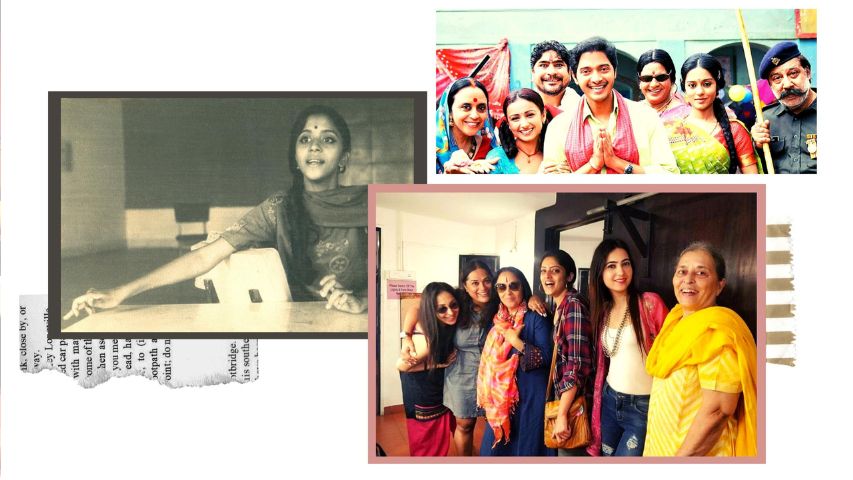
Ila, now to go back to your beginnings. Tell us about your family. You were born in 1954 at Jodhpur in Rajasthan, but spent years in Jaipur. You’ll were nine surviving siblings. As a single child of my parents, I envy you. From whatever little I know or can gauge, all you sisters-brothers were given the freedom to build for yourselves empowering lives and career. Kudos to your parents.
My mother’s name was Bhagwati Pandey and my father’s name was Shri Indra Narayan Pandey. He was a general manager in a cooperative bank. We were seven sisters and two brothers. Out of the seven we have lost two precious sisters.
My parents were very fond of reading and writing. My mother was a standard 8 pass-out and would read all the Bengali writers. She was very fond of reading the stories and articles that would get serialized in Saptahik Hindustan and Dharmyug. So, she would borrow these two from the magazine vendor every week, read and then duly return them.
My parents educated all their children. My father was also the editor of the Hindi newspaper Prajapati. At home music got served as salt in food. My mother made her daughters study. Many of my sisters did their double Masters. Some became principals in schools. One of my sisters worked with the BBC. Another with the tourism department. Not that anyone in the family became Firaq Gorakhpuri or Premchand, but all are culture inclined. I did not get trained in a musical institution. It was much later in life that I did a short-term course in drama when I got a scholarship from Rajasthan Sangeet Kala Academy, Jodhpur. After that I went to the NSD.
You have talked of your domestic helper Raghunath and maids in Rajasthan singing and that struck the musical chord in you. Add more.
Earliest notes of folk music I learnt from Raghunath while being escorted to KG school. In Rajasthan no labourer, truck driver or bullock-cart-driver can function without singing. Music stimulates them. My introduction to folk music was also via gehun-ginne (wheat chafing) activity.
Did school and college provide you with the creative platforms? You would participate in radio, theatre, music, debates…
Yes, my school was Choti Chaupar Maharaja Bahuteshi Uchatar Madhyamik Kanya Vidyalaya. Multipurpose Higher Secondary School. That is why I am multipurpose. This palace-structured heritage school has completed 150 years now. I started my radio participation from there. Then came theatre, debates, singing and dance. Jaipur provided me with a great platform. Incidentally I met Prithviraj Kapoorji when he came to shoot for the film Rajkumar. I had also sung for him. I could sing in both the female and male voice. It was a Punjabi song.
I also learnt folk songs while participating in the tableaus for the 26th January (Republic Day) parade. My college would select me. I was very patriotic. I was born a few years after India’s independence. There was josh and jazba. That is missing now. It is not to be found in our politicians nor in the people. We are just alive.
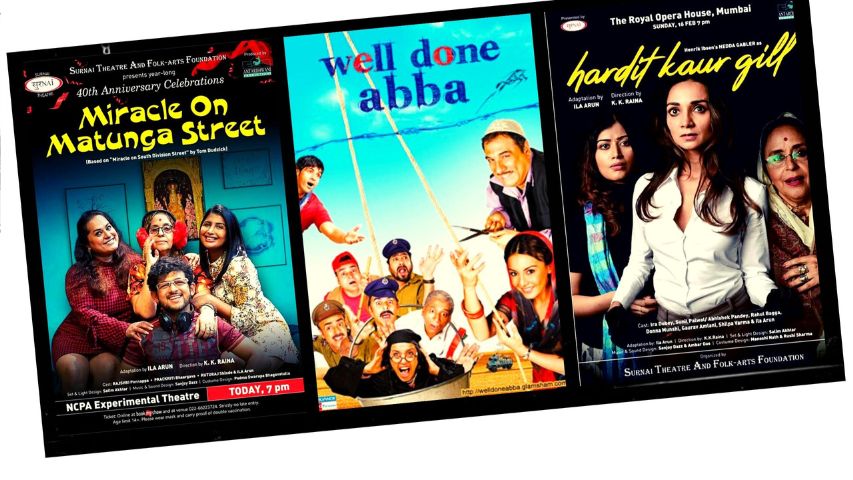
When did Bombay beckon you? Did you come here after marriage to Arun?
Soon after passing the NSD, Arun’s proposal came. Then Arun and I both thought that we should make Bombay our base. For him there were many merchant-navy companies here. I saw for myself better possibilities for theatre. In Bombay we started looking for a house. Kalyanjibhai (Kalyanji Anandji) was a very dear friend from Jaipur. Their shows would be held there. One also knew Hangal Saheb. He suggested this house where we live. I thought it was a good idea as Prithvi theatre was nearby and also Hangal Saab. So, we bought our house.
Your brothers Piyush Pandey, Prasoon Pandey are very noted media, advertising creative heads. Tell us about shared moments.
Piyush and Prasoon, my brothers, are younger to me. After the seven surviving sisters the two most precious brothers were born. When Piyush wanted to explore advertising and come to Bombay, I and Arun happened to be here already. We were living in a small two-bedroom house. Ishita was also born there.
Piyush asked me if he could come stay with me. I said, ‘Oh that will be a pleasure.’ Here my brother was mine alone and not shared with other sisters. It was a great pleasure for me to have him for all those five years. Then Prasoon came and made a very creative career. There is an old native saying that translates such - if you put water in seven mud-vessels (matkas) and make a hole in them, you will find that the cleanest water reaches the last vessel only. I always say that Prasoon is the last matka of the family who got all the creativity in him. His dream of NID was realized by Piyush’s support. We helped each other. These two brothers now support us at this age. They are very precious.
I must herein make a claim here. I am the first one in the family to do advertising. It is acknowledged by Piyush in his book Pandeymonium. After marriage, when Arun went sailing, I went to Jaipur. Blaze had just started their Vividh Bharati Jaipur commercial advertising. It wanted to make radio spots. A person brought jingles to me to sing. My first one was a 30-seconder for Rajasthan small scale industry. Arun had one Akai spool tape. Prasoon, who was still in school, made a fantastic studio at home with sound proof mattresses. We recorded on that. Piyush gave his voice for many jingles including for Jhago Sabun. We were experts for agarbatti, banyan, sabun, taala. Nobody knows that I have made almost 200 jingles for Jaipur radio station, Vividh Bharati. I still have that spool with me.
So, my connect with advertising had already there in Jaipur during my nascent years. When Piyush and Prasoon got connected with Indian advertising, Prasoon with Lintas and Piyush with O&M, at that time Indian advertising would think and deliver in English. These brothers changed the lingo and brought in the local, native sound. Like Mera Wala Blue. They contributed immensely to Indian advertising. Look at Prasoon’s Fevicol advertisements! In their advertising films there was no need for models. They used local faces. Back in the years Ponds had contacted me through O&M for their product launch events. In the soap launch I brought in the qawaali, what is called bent-baazi. ‘Ismein kya badhiya hai, ismein kya badhiya hai?’ Then I got to launch their powder and toothpaste as well.
That is why Piyush acknowledges that his penchant for advertising was influenced by me. Then the roles reversed. Now he gives me better work and opportunities. Life has come full circle.
As a film actor my earliest recall is of you in Ardh Satya (1983), as Sneha Bajpayee. Then of course Mandi (1983).
In Ardh Satya Govind Nihalani gave me the role. It was a small part but I wanted to be a part of Govind’s vision. The most important part for me was the opportunity to become a good friend of Smita Patil. We spent so much time together. I miss her a lot. A lovely actress and a very fine human being. Mandi gifted me with lifelong friends. Shabana is my good friend. She gave me a lot of support. I lost Smita but I always had Shabana. Mandi also gave me two more friends, Neena Gupta and Soni Razdan. The third one, Anita Kanwar, disappeared.
I enjoyed Govind Nihalani’s works: Ardh Satya, Party, Drohkaal. In Rukmavati ki Haveli I played the elder sister. I also did the music. I enjoyed doing all the serials and films with Govind Nihalani, Vijayabai, Shyam Benegal, Rajkumar Santoshi, Ashutosh Gowariker. Maine struggle toh kiya hi nahi. Even as an actor I did not have to go through any casting couch. I did not have to get a portfolio made.
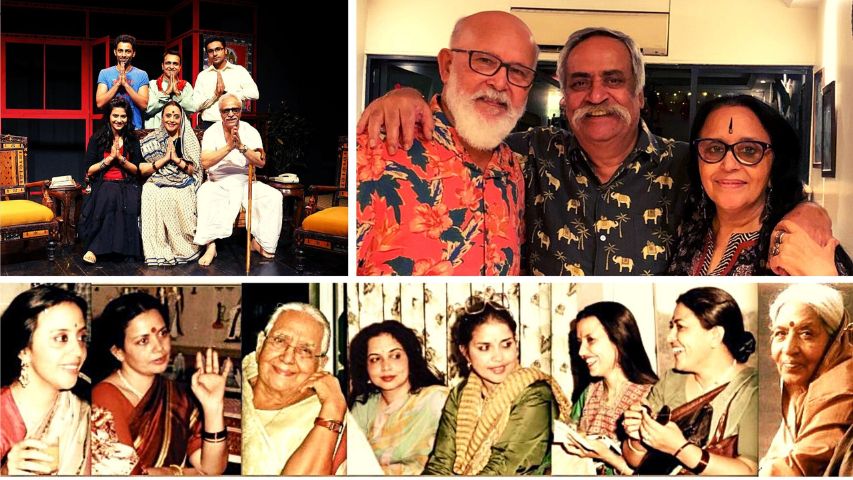
Our television as a medium got nurtured in the 1980s and 1990s with very fine sensibilities. We were a lucky generation. One recalls you in Kabeer, Lifeline. Through the years you were a very good part of DD’s trajectory of great work. Notably in Shyam Benegal’s Yatra, Bharat Ek Khoj, Samvidhan and Govind Nihalani’s Tamas.
Doordarshan and TV was not new to me. In Jaipur I did a series called Mauj Masti. I had appeared in Vinod Dua’s youth program. It got a fantastic response. Then I came to Bombay and did a show with Manju Singh, called Show Theme. Later it came to be called Show Time. From there my musical journey had started. I not only was a compere but also sang folk songs and then filmy songs. That became a highlight and Bombay’s collective eyes fell on me. That is how HMV also contacted me.
I did Kabir with Annu Kapoor. I acted as Kabir’s mother and sang a song also. Then I did Lifeline. Yatra was a great experience! For one and a half months we travelled on a special train from Kashmir to Kanyakumari, east to west of India. How can I forget Om Puriji who made his train coupe like his house and would invite us, ‘Come home in the evening!’
I remember my daughter Ishitta was in school. So, Shyam Babu wrote a wonderful letter to the headmistress of Arya Vidya Mandir saying, ‘This girl is doing a role in my Yatra and this experience will be bigger than any school experience that she will come and share with everybody.’ When we were in the South with Yatra I showed Ishitta how the Kathakali make-up gets done. Shyam Benegal films, be it Mandi, Antarnaad, Welcome to Sajjanpur or Well Done Abba, they educated us and increased our vision. If Ebrahim Alkazi saheb and Shyam Benegal were not around then I would have remained restricted to being just a folk person. There would’ve been no other dimension to me. Without going to RADA or any such international institute, but just by being in the company of people like them, gave one so much! A world-view.
Bharat Ek Khoj team was like a repertory. Every episode was a new chapter in my life. I did the Gandhi episode with Shabana Azmi. If out of the roles I played in Bharat Ek Khoj I have to choose one, then it will be Gandhari. Later I essayed the same in the play Shabd Leela. In Bharat Ek Khoj when Dharamvir Bharatiji saw me as Gandhari he remarked, “Gandhari toh bahut ne kiya hai. Badi manjhi kalakaron ne. Par usko apne ek different layer aur connectivity di. Aisi Gandhari nahi dekhi’.
I had gone and asked Shyam Babu for this role. One day I caught him at the canteen of Filmcity. I said, ‘Sir enough is enough. I am ready to stand on one leg at Santacruz chauraha. You have to take my audition.’ I gave the audition and got the role. Salim (Ghouse) beautifully enacted Krishna. Shyam Babu’s concept to present Krishna as charwaha/herdsman, a human being, not as God was so good. When Gandhari talks to Krishna it is not as if she is addressing God, but a one-on-one. Then Gandhari’s curse and the realization of it! Each time I do Gandhari I enter a different zone. Gandhari is Shyam Babu’s gift to me in Bharat Ek Khoj.
The television work I chose to do were classics. Tamas being one. I played Lalaji’s wife, the folks who get left behind. Harish Patel played Laalaji. Then I did teleplays like The House of Bernarda Alba as Rukmavati ki Haveli adapted in Rajasthan milieu. My involvement was from costume to dialect. Likewise with Gajendra Singh I did Sur Manthan for the deaf and dumb.
Later in Samvidhan Shyam Babu gave me the role of Hansa Mehta. I learnt so much about the making of the constitution. It was an honour. We went with Shyam Babu to the parliament. As I said it’s a treat to work with Shyam Babu.
You also kind of pioneered live shows.
It was from my Ila Arun live music shows that I earned the most. I got my rate and audience. You need jaan, stamina, to carry a show with forty to two-hundred folk-artistes. I cannot forget the 1993 show for Dainik Bhaskar. One and a half lakh people had come to watch it. They were sitting since the morning for the show to begin as if they were waiting for Santoshi Mata. Choli ke Peeche had happened and people wanted to listen to it. The collector came to say I cannot interact with the audience. But I love to interact with the audience. I am on such a high that I can jump and land anywhere in the crowd.
Once a journalist while complimenting me called me ‘Poor man’s Reshma’. I sang folk songs in my own style. I worship Reshma. If even two percent of her gayaki comes in me then I am honored. I always maintain that I am a gypsy at heart. My music is also of a gypsy’s. Banjaran. Because of the private albums I had done, I got live shows. I am the queen of marriages. I am very grateful to the Marwaris who have loved me for my Marwari songs. At Agra I had an audience eighteen-thousand strong for my show. At Indore one and a half lakh people. Even in America. While I like abandon and openness in singing and in acting I like a more intimate atmosphere in theatre. So, I prefer Prithvi theatre.
Years back I did for MTV their first folk song. Malaika Arora featured in that music video. Mahesh Mathai directed it. Then for Coke Studio I sang my single with Dhruv Ghanekar. I have gone global. At Norway I did a big global fusion concert with Dhruv. I have sung many songs with rappers. God has given me better ears than voice for music. I listen to all kinds of music. I can be sitting for a choir the whole night. I can sit for qawwali in the mazar for the whole night. I can be with the Bastar tribals for the whole night. My canvas for listening is vast. You get inspiration. In my folk shows tribals have participated. Our tribals are folk artists. I have travelled with them all over Europe. ICCR had sent me. I also did a very beautiful show for Sony, A musical Sandstorm, with 200 artists.
Your work on satellite television continued as judge and participant.
Fame Gurukul was a reality show. My first reality show. I played the headmistress. It had a very interesting format. The judges were Javed Akhtar Bhai, KK (singer) and Shankar Mahadevan. Students also had veto power. I too had the veto power. Using this veto power I tried to save Arijit Singh, but finally he became a victim to the politics. And Qazi from Kashmir won. He got a lot of votes. The tragedy of reality shows is that less talent and more votes makes the winner. Imagine that Arijit Singh who I supported is today considered India’s topmost singer. Most popular. I am proud that I recognized Arijit’s sur.
Then I did Junoon Kuch Kar Dikhane Ka. Rahat Fateh Ali Khan Saheb wrote the Sufi part and I the main folk. Annu Kapoor was the compere.
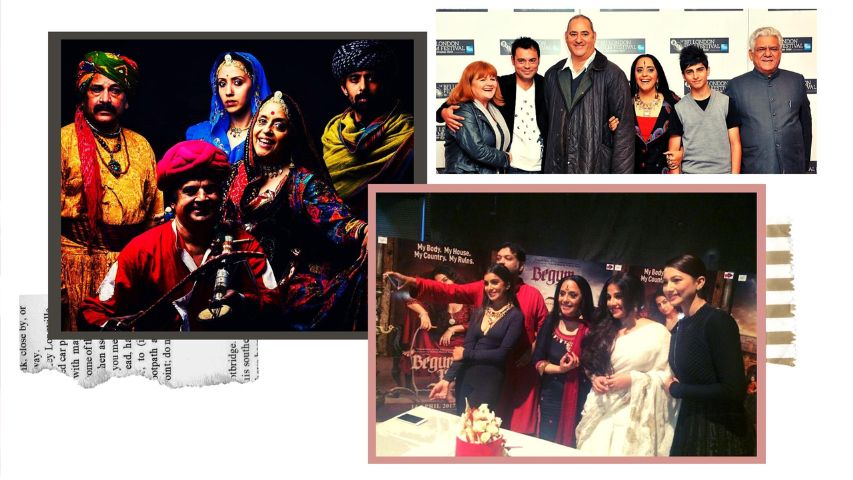
Your role in British film West is West (2008) got marked.
Basheera Khan. I really liked my role. I worked with Om Puriji in this and played his second wife. At Abu Dhabi I got the best supporting actress award and also a nomination at Toronto Film Festival. There is a very nice scene between me and Omji’s first wife. She does not know Hindi and I don’t know English. The scene and enactment got me the award nomination.
Your private non-film music albums added to your repertoire.
I did ten albums that include Banjaran, Chappan Churi, Titli, Main Hoon Sawa Lakh Ki, Vote for Ghagra, Khichdi.
As a playback singer in Hindi films, you made a gharana of your own kind. It would have been a longish struggle.
My first film song was for the film Aitbaar. For Bappida I sang Khali Peeli Pyaar Mein. Very naughty song. But the film was not a hit. There came a gap.
I recall that during the shoot of Shyam Benegal’s Mandi we would travel in the bus to the location, a little away from Hyderabad. Annu Kapoor was with us. He would play antakshari. I would also sing in that group. Shabana Azmi noticed me. Later she introduced me to Mahesh Bhatt. I sang in front of him. Mahesh said, ‘She reminds me of Donna Summer and Tina Turner.’ Mind you back then I had not even heard their names. Then Mahesh Bhatt offered me a song in his film Aashiana. It had Jagjit Singh’s music. The song was ‘Jawani re kaise kaatoon?’ It had my take. Jagjitji modernized it a little. That gypsy song turned out to be beautiful. That was my first song, I think, before Aitbaar. I went on to sing for each music director in the industry. With Laxmikant-Pyarelal I sang four-five songs, including Choli Ke Peeche Kya Hai along with Alka Yagnik. After Choli, I did a world tour of concerts for the Moranis with stars, led by Shahrukh Khan.
When I was recording for my private albums Yashji was making Lamhe. He saw my performance at a music launch. Yashji offered me 'Morni Baga Ma' song. Pandit Shivkumar Sharma and Hariprasad Chaurasiaji composed it. We set the song on the original folk song. Among my Bollywood works, of course, I loved Choli Ke Peeche and Morni Baga Ma.
I somehow never took myself very seriously as a playback singer. I was conscious that I am primarily a theatre person. But it is my songs that have made me truly famous. I have sung for AR Rahman. Fact is that there are better singers than me. But there was a time when piracy of my songs was being done by some singers.
I have no problem being labelled with the ‘Item number’. There are item numbers in Bollywood. Like there used to be Helenji’s cabaret or mujra. My voice is either used in the background, or in item numbers. I cannot be ungrateful to the film industry. I am lucky that I am known by my private albums. The music companies knew that there is a section of people who love the private albums.
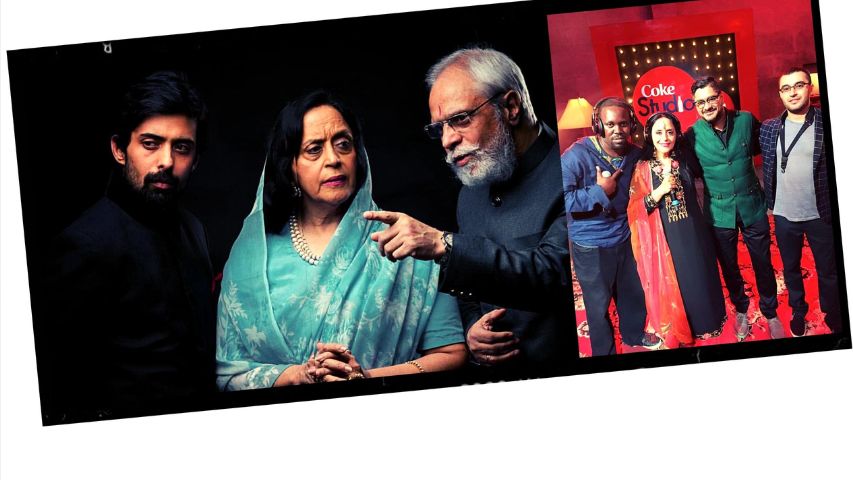
You have, as a music director, given film music.
Yes. I gave the music for Gopi Desai’s film Mujhse Dosti Karoge. And wrote the songs.
Tell us of the work lined-up.
My new album is ready. I will release it on YouTube by the end of this year. I am also doing a single with Dhruv Ghanekar. My brother Piyush Pandey told me, ‘Front foot se khel jao.’ I have made my own album. There is no business ethics in India. Music companies want to exhaust you. They will take your creativity and then piracy will follow. Piracy is like a bug eating into us. I will definitely bring out my new album as a single. There are ten songs therein.
Tell us about daughter Ishitta Arun.
Ishitta is my only child. I wanted a girl always and only one child. She completes my life. I never promoted Ishitta. Her first appearance was at age three as a child in the Vicks advertisement. They took her along with Jayant Kripalani. She says ‘Vicks ki goli lo kich kich door karo’ and winks. So many versions have been made but that was so impactful. I would now want that the Vicks people remake the advertisement with adult Ishitta narrating the ‘Phir bhediye ne kaha…’ and her daughter Alaya acting and listening to her.
Then in Shyam Babu’s Yatra she travelled with all of us. She did a small role in that nautanki troupe act. Later as a young girl Ishitta was a VJ. She also participated in the Ms. India competition. Priyanka Chopra, Lara Dutta are the winners of her time. Ishitta came at no 9. She has kept her fitness regime admirably well. She has done important plays with me as the lead. She has done three films as a heroine. As an actress she comes across very powerfully. She also sings very well. But she still has to decide the line she wants to take. She also produced a play with her own story - Ga Re Ma.
Ishitta is married to Dhruv Ghanekar who is a music-producer and gives music in advertising films. He is an artist and Ishitta has her own mind. I had done the film Swayam with Mahesh Bhatt. In it Waheeda Rehman has two daughters. One was Soni and the other one me. At one moment we tell our mother, ‘Aao Ma hum tumhara haath pakad lein’. She replies, ‘Nahi, main ungli pakad ke nahi chalna chahungi.’ Today I relate to that sentiment. I pray God gives me the strength to walk on my own all my life.
Ishitta is a good girl. She is also witty. I feel within her resides Mehmood, Rajendranath and Johny Lever combined. As a mother she is sensitive and lovely. And I am blessed with two granddaughters, Amala and Alaya. The role of a grandmother in life has its own charm.
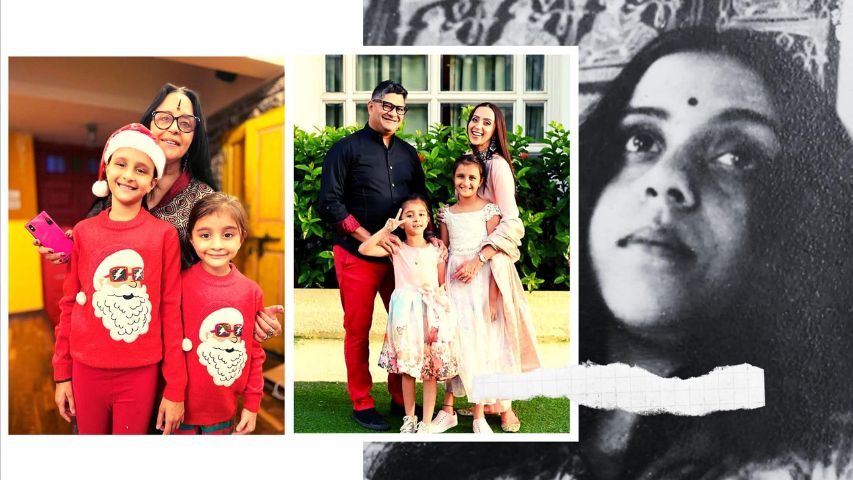
How do you assess today’s young generation and especially girls?
In some respect today’s girls are better than us in our time. They are very technology savvy. They have a mind of their own. They are much more aware than we were. But they can in the rush of life drift. In theater I interact with so many young girls. I am a woman first. I do care to forewarn them regarding the misconceptions of glamor in Mumbai and Bollywood. ‘Chahate ho aakash choona, toh dhara par paon teko.’ The roots must be deep and strong. Not frivolous. There is something missing. Many of them get caught in their own web. The girls today are very intelligent and beautiful but they have to be responsible towards themselves.
And finally, Ila with your spirit there is only looking ahead…
It is my husband’s dream that like Tina Turner at the age of 72 I too should at that age create a dhamaal on stage. I am quite capable of doing that. ‘All the world’s a stage.’ Rangmanch hai ye duniya saari. One day when I am gone, I will be just another story. That is why I want to write a book.
I have a property in Malad, and my dream is that I construct a small theatre of my own, sit there in my old age in costume, like Habib Tanvir and Moneeka would, and sell the tickets. Till the very end I want to remain connected with my theatre and watch my group perform.

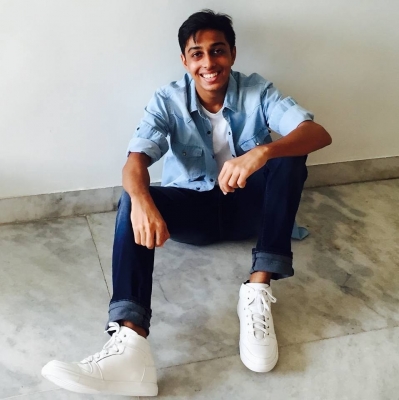



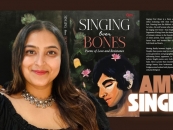
-173X130.jpg)
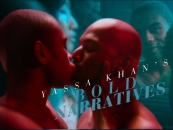
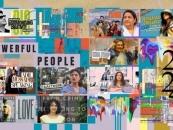
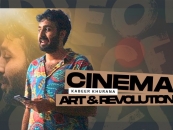
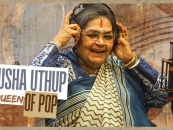
-173X130.jpg)
